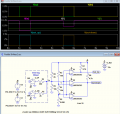Hi All! I’m hoping an expert can steer me in the right direction.
I’m developing a set of custom paddle shifters on my car steering wheel. How it works is there are two wires taken from a stock shift button on the floor shifter that I extended through the steering column to a set of paddles i installed on the steering wheel. Each wire goes to a paddle, one for upshifting one for downshifting. When a paddle is pressed the current to that paddle is grounded and the transmissions shifts. Fairly simple.
The problem is there is only 1 available wire in the steering column's clockspring. Previously I disconnected the cruise control and used that wire but I would like to gain functionality of both the paddles and the cruise control.
I understand that the stock buttons on the steering wheel each have a different electrical resistance which allows many switches to operate through the fewer number of wires of the clockspring. I believe this works on the principle that the electronics can tell from the resistance which button is being pressed on the wheel. (Please correct me if this is wrong). Using the same principal I would like to add some type of resistance sensitive circuit on both sides of the single open clockspring wire so that I could operate both paddles through the single wire. Any suggestions? Please be as detailed as possible as I don't know much about electrical engineering. Thanks you! - Marc
I’m developing a set of custom paddle shifters on my car steering wheel. How it works is there are two wires taken from a stock shift button on the floor shifter that I extended through the steering column to a set of paddles i installed on the steering wheel. Each wire goes to a paddle, one for upshifting one for downshifting. When a paddle is pressed the current to that paddle is grounded and the transmissions shifts. Fairly simple.
The problem is there is only 1 available wire in the steering column's clockspring. Previously I disconnected the cruise control and used that wire but I would like to gain functionality of both the paddles and the cruise control.
I understand that the stock buttons on the steering wheel each have a different electrical resistance which allows many switches to operate through the fewer number of wires of the clockspring. I believe this works on the principle that the electronics can tell from the resistance which button is being pressed on the wheel. (Please correct me if this is wrong). Using the same principal I would like to add some type of resistance sensitive circuit on both sides of the single open clockspring wire so that I could operate both paddles through the single wire. Any suggestions? Please be as detailed as possible as I don't know much about electrical engineering. Thanks you! - Marc









